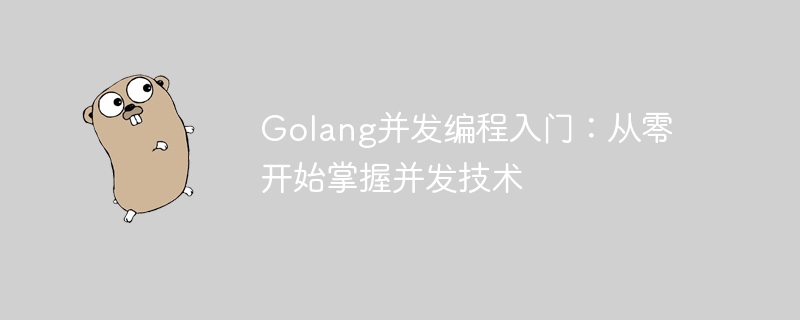

Introduction to concurrent programming in Golang: Mastering concurrency technology from scratch requires specific code examples
Introduction:
In today's rapidly developing field of computer science, how to fully Exploiting the parallel capabilities of multi-core processors has become an important topic. Concurrent programming, the execution of multiple tasks simultaneously, has become an important feature of modern programming languages. In this regard, Golang, as a programming language that supports efficient concurrent programming, has been widely favored by developers. This article will introduce the basic concurrent programming concepts of Golang from scratch, and help readers better understand and master the concurrency technology in Golang through specific code examples.
1. Golang’s concurrency model
Golang adopts the CSP (Communicating Sequential Process) model to implement concurrent programming. In this model, different concurrent entities collaborate through communication rather than shared memory. This can effectively avoid some common problems in multi-threaded programming, such as data competition. Golang provides some keywords (such as goroutine, channel, etc.) to simplify concurrent programming, making it easier for developers to use concurrency technology.
2. Goroutine in Golang
Goroutine is the basic unit for achieving concurrency in Golang. Goroutine is a lightweight thread that can execute blocks of code concurrently. Compared with traditional threads, the overhead of creating and destroying Goroutines is smaller, so more Goroutines can be created to process tasks in parallel. The following is a simple sample code that shows how to use Goroutine to execute tasks concurrently:
package main
import (
"fmt"
"time"
)
func task1() {
for i := 0; i < 10; i++ {
fmt.Println("Task 1: ", i)
time.Sleep(time.Millisecond * 500)
}
}
func task2() {
for i := 0; i < 10; i++ {
fmt.Println("Task 2: ", i)
time.Sleep(time.Millisecond * 500)
}
}
func main() {
go task1()
go task2()
// 等待两个任务完成
time.Sleep(time.Second * 6)
}In this code, the task1 and task2 functions represent two needs Concurrently executed tasks. By using the go keyword, we can start both tasks at the same time in the main function. Since Golang's scheduler can intelligently manage the execution of concurrent tasks, these two tasks will be executed concurrently. Finally, we wait for the completion of the two tasks by calling the time.Sleep method. Run the program and you can see the results of the two tasks being executed alternately.
3. Channel in Golang
Channel is a mechanism for concurrent communication in Golang, which can be used to transfer data between Goroutines. Channel can be used to both send data and receive data. Goroutine can send data to another Goroutine through Channel, and can also receive data sent by other Goroutine through Channel.
The following is a sample code that uses Channel for concurrent communication:
package main
import "fmt"
func process(ch chan int) {
for i := 0; i < 5; i++ {
ch <- i // 发送数据到channel
}
close(ch) // 关闭channel
}
func main() {
ch := make(chan int) // 创建一个channel
go process(ch) // 启动一个Goroutine来处理数据
for {
value, ok := <-ch // 从channel接收数据
if !ok {
break
}
fmt.Println("Received:", value)
}
}In this code, the process function uses ch <- i## The # statement sends i to the channel. In the main function, we receive data from the channel through value, ok := <-ch. When the channel is closed, the value of ok will be false. We can check whether there is still data to receive by checking the value of ok.
In concurrent programming, synchronization operations are very important. Golang provides a variety of synchronization methods, such as using
WaitGroup, Mutex, etc. in the sync package. These synchronization mechanisms can help us control the execution order of concurrent tasks and avoid problems such as data competition.
sync.WaitGroup to implement concurrent tasks:
package main
import (
"fmt"
"sync"
"time"
)
func task(id int, wg *sync.WaitGroup) {
defer wg.Done()
fmt.Println("Task", id, "is running...")
time.Sleep(time.Second)
fmt.Println("Task", id, "is done.")
}
func main() {
var wg sync.WaitGroup
for i := 1; i <= 3; i++ {
wg.Add(1)
go task(i, &wg)
}
wg.Wait()
fmt.Println("All tasks are done.")
}sync.WaitGroupExamplewg to manage the execution of concurrent tasks. In the task function, we use wg.Done() to indicate task completion, and pass wg.Wait()## in the main function #Wait for all tasks to be completed. When you run the program, you can see that the tasks are executed concurrently in order, and "All tasks are done." is printed after waiting for all tasks to be completed. Summary:
The above is the detailed content of Learn and master Golang's concurrent programming technology from scratch. For more information, please follow other related articles on the PHP Chinese website!
 How to define variables in golang
How to define variables in golang
 What are the data conversion methods in golang?
What are the data conversion methods in golang?
 What are the commonly used libraries in golang?
What are the commonly used libraries in golang?
 What is the difference between golang and python
What is the difference between golang and python
 How to clear stringbuilder
How to clear stringbuilder
 ones function usage
ones function usage
 How to withdraw fees on WeChat
How to withdraw fees on WeChat
 Solution to split word table into two pages
Solution to split word table into two pages
 How to insert audio into ppt
How to insert audio into ppt